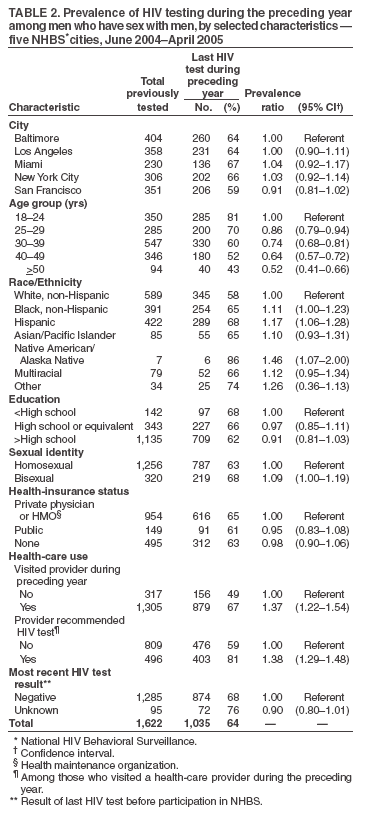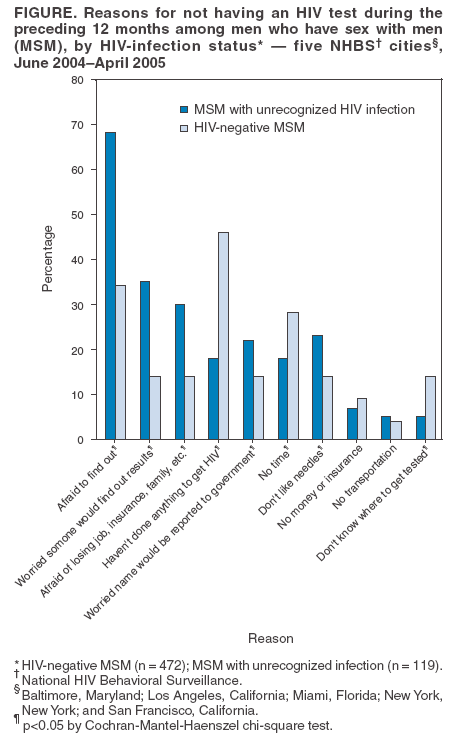 |
|
|
|
|
|
|
|
|
|
Home |
Climate Change Project |
Table of Contents |
Courses | Search |
|
|
|
|
|
|
|
||||
| ||||||||||
|
|
| Weekly |
| June 24, 2005 / 54(24);597-601 |
|
|
HIV Prevalence, Unrecognized Infection, and HIV Testing Among Men Who Have Sex with Men --- Five U.S. Cities, June 2004--April 2005Well into the third decade of the human immunodeficiency virus (HIV) epidemic, rates of HIV infection remain high, especially among minority populations. Of newly diagnosed HIV infections in the United States during 2003, CDC estimated that approximately 63% were among men who were infected through sexual contact with other men, 50% were among blacks, 32% were among whites, and 16% were among Hispanics (1). Studies of HIV infection among young men who have sex with men (MSM) in the mid to late 1990s revealed high rates of HIV prevalence, incidence, and unrecognized infection, particularly among young black MSM (2--4). To reassess those findings and previous HIV testing behaviors among MSM, CDC analyzed data from five of 17 cities participating in the National HIV Behavioral Surveillance (NHBS) system. This report summarizes preliminary findings from the HIV-testing component of NHBS, which indicated that, of MSM surveyed, 25% were infected with HIV, and 48% of those infected were unaware of their infection. To decrease HIV transmission, MSM should be encouraged to receive an HIV test at least annually, and prevention programs should improve means of reaching persons unaware of their HIV status, especially those in populations disproportionately at risk. NHBS is an ongoing behavioral surveillance system that collects cross-sectional data among populations at high risk for acquiring HIV, including MSM, injection-drug users, and heterosexuals at high risk. Men aged >18 years were sampled systematically from randomly selected venues where MSM congregated (e.g., bars/clubs, organizations, and street locations). Formative research was conducted to identify venues and days and times when MSM frequented these venues (2--4). Men eligible for the survey were aged >18 years and residents of the metropolitan statistical area (MSA). Using a standardized questionnaire, men were interviewed about their sexual and drug-use behaviors, HIV-testing behavior, and use of HIV-prevention services. During June 2004--April 2005, participants in five NHBS cities (Baltimore, Maryland; Los Angeles, California; Miami, Florida; New York, New York; and San Francisco, California) were also tested for HIV infection after informed consent. The OraQuick® rapid test or an enzyme immunoassay (EIA) was used to screen blood specimens for HIV antibody, and initially reactive specimens were tested by Western blot for confirmation. To estimate HIV incidence, CDC used a serologic testing algorithm for recent HIV seroconversion (STARHS) (5). Specimens that were confirmed positive were tested further with the Vironostika-Less Sensitive (LS) EIA, which detects HIV infection approximately 170 days after initial infection by using a 1.0 standard optical density cutoff (95% confidence interval [CI] = 145--200 days) (6). A specimen confirmed positive by Western blot and nonreactive on the Vironostika-LS assay was categorized as an incident infection. Persons self-reporting a previous positive test result and HIV-positive participants reporting use of antiretroviral therapy were excluded from the incidence estimate. Participants were asked about the date and result of their most recent HIV test before having their blood drawn as part of NHBS. Men who had not been tested during the preceding year were asked about their reasons for not being tested. MSM with unrecognized infection were defined as those who reported being HIV negative, indeterminate, or not knowing their HIV status, but who tested HIV positive at the time of their interview. Prevalence ratios and 95% CIs were calculated to evaluate characteristics associated with testing during the preceding year. Differences in reasons for not testing between HIV-negative MSM and MSM with unrecognized infection were assessed by using chi-square tests (p<0.05). In the five cities, 2,261 men sampled from 258 venues participated in NHBS. The participation rate among eligible men was 83% (range by city: 69%--99%). A total of 1,767 (78%) were men who had one or more male sex partners and agreed to the survey, HIV test, and STARHS test (range by city: 222--462). Of these 1,767 participants, the median age was 32 years (range: 18--81 years); 35% were white, 27% Hispanic, 25% black, 7% multiracial/other, and 6% Asian/Pacific Islander. Participants were recruited at bars (30%), street locations (20%), dance clubs (19%), cafes/retail stores (10%), Gay Pride events (6%), social organizations (5%), gyms (5%), sex establishments (3%), and parks (1%). Of the 1,767 MSM, 450 (25%) tested positive for HIV (range by city: 18%--40%). HIV prevalence was 46% among blacks, 21% among whites, and 17% among Hispanics. A total of 340 (76%) of those who were HIV positive were aged >30 years (Table 1). Of the 449 HIV-antibody--positive specimens tested by Vironostika-LS, 80 were nonreactive; of these, 31 were considered incident infections, and 49 were excluded from the incidence estimate. HIV incidence among MSM by city was as follows: Baltimore, 8.0% (95% CI = 4.2%--11.8%); Los Angeles, 1.4% (95% CI = 0.0%--2.9%); Miami, 2.6% (95% CI = 0.0%--5.6%); New York City, 2.3% (95% CI = 0.28%--4.2%); and San Francisco, 1.2% (95% CI = 0.0%--2.6%). Of the 450 HIV-infected MSM, 217 (48%) were unaware of their HIV infections. The proportion of unrecognized HIV infection was highest among MSM who were aged <30 years, nonwhite, and surveyed in the four cities other than San Francisco (Table 1). Of the 217 MSM with unrecognized HIV infections, 64% were black, 18% Hispanic, 11% white, and 6% multiracial/other. The majority (184 [84%]) of the 217 MSM with unrecognized HIV infection had previously been tested for HIV; 145 (79%) reported that their most recent test result was negative, 33 (18%) were unknown, and six (3%) were indeterminate. Approximately 58% of MSM with unrecognized infections had not been tested during the preceding year. Compared with MSM who were HIV negative, proportionally more MSM with unrecognized infections had not been tested during the preceding year because they were afraid of learning they had HIV (34% versus 68%; p<0.0001) and were worried others would find out the result (14% versus 35%; p<0.0001) (Figure). Nearly all participants (92%) reported previously being tested for HIV, and 64% reported being tested during the preceding year. MSM were more likely to have been tested during the preceding year if they had visited a health-care provider and their provider recommended an HIV test (Table 2). Sexual and drug-use behaviors were not associated with testing during the preceding year. Reported by: F Sifakis, PhD, Johns Hopkins Bloomberg School of Public Health, Baltimore; CP Flynn, ScM, Maryland Dept of Health and Mental Hygiene. L Metsch, PhD, Univ of Miami; M LaLota, MPH, Florida Dept of Health. C Murrill, PhD, New York City Dept of Health; BA Koblin, PhD, New York Blood Center, New York. T Bingham, MPH, Los Angeles County Dept of Health Svcs; W McFarland, MD, H Raymond, San Francisco Dept of Public Health, California. S Behel, MPH, A Lansky, PhD, B Byers, PhD, D MacKellar, MPH, A Drake, MPH, K Gallagher, DSc, Div of HIV/AIDS Prevention, National Center for HIV, STD, and TB Prevention, CDC. Editorial Note:Consistent with previous studies of young MSM conducted in the same cities using similar sampling methods (2--4,7,8), this study revealed that 1) prevalence and incidence of HIV infection in this population were high; 2) many HIV-infected MSM, particularly younger and black MSM, were unaware they were HIV-infected; and 3) among MSM with unrecognized infection, nearly half presumably acquired HIV during the preceding year, and many had not been tested recently because of fears of testing positive. These findings underscore the need to increase testing and improve primary prevention practices for MSM. Although a majority of MSM had been tested during the preceding year, more than half with unrecognized infections had not had an annual test. The results of this study support CDC guidelines recommending at least annual testing for sexually active MSM (8), especially among younger MSM and minority populations (7). The findings in this report are subject to at least four limitations. First, the date of a participant's most recent HIV test is self-reported and might be subject to reporting inaccuracies. Second, given the sensitive nature of some questions, HIV status might have been underreported during the interview, thereby inflating estimates of unrecognized infections. Third, these findings are limited to men who frequented MSM-identified venues in the five selected cities during the survey period. Although similar rates of HIV incidence were observed compared with previous surveys (2), the limited number of incident cases prevents comparisons by race and age. Finally, data are preliminary and have not been weighted by venue-selection probability. The 2004 NHBS system was conducted in 17 MSAs with the highest AIDS prevalence. Although this report focuses on testing results from five selected cities, behavioral data are forthcoming from all participating cities. NHBS is an important tool for monitoring the impact of the HIV epidemic and informing prevention efforts. HIV incidence and prevalence are high among MSM, and many are unaware they are HIV positive. The high level of unrecognized HIV infections among MSM is a public health concern. Persons aware of their HIV infection often take steps to reduce their risk behaviors, which could reduce HIV transmission (9). To increase the proportion of HIV-positive persons who know they are infected, sexually active MSM should be encouraged to have an HIV test at least annually. Corresponding efforts should be developed to address barriers to testing, particularly those related to fear, and to increase the availability of testing in clinical and nonclinical settings (10). Testing programs should target both younger MSM and black MSM to reach populations disproportionately unaware they are HIV positive. References
Table 1  Return to top. Table 2  Return to top. Figure  Return to top.
All MMWR HTML versions of articles are electronic conversions from ASCII text into HTML. This conversion may have resulted in character translation or format errors in the HTML version. Users should not rely on this HTML document, but are referred to the electronic PDF version and/or the original MMWR paper copy for the official text, figures, and tables. An original paper copy of this issue can be obtained from the Superintendent of Documents, U.S. Government Printing Office (GPO), Washington, DC 20402-9371; telephone: (202) 512-1800. Contact GPO for current prices. **Questions or messages regarding errors in formatting should be addressed to mmwrq@cdc.gov.Page converted: 6/22/2005 |
|||||||||
This page last reviewed 6/22/2005
|
The Climate Change and Public Health Law Site
The Best on the WWW Since 1995!
Copyright as to non-public domain materials
See DR-KATE.COM for home hurricane and disaster preparation
See WWW.EPR-ART.COM for photography of southern Louisiana and Hurricane Katrina
Professor Edward P. Richards, III, JD, MPH - Webmaster
Provide Website Feedback - https://www.lsu.edu/feedback
Privacy Statement - https://www.lsu.edu/privacy
Accessibility Statement - https://www.lsu.edu/accessibility